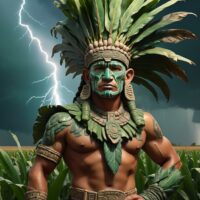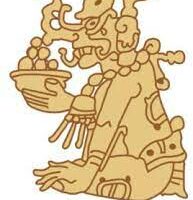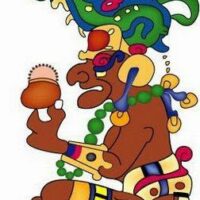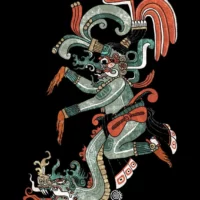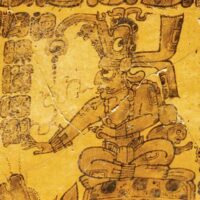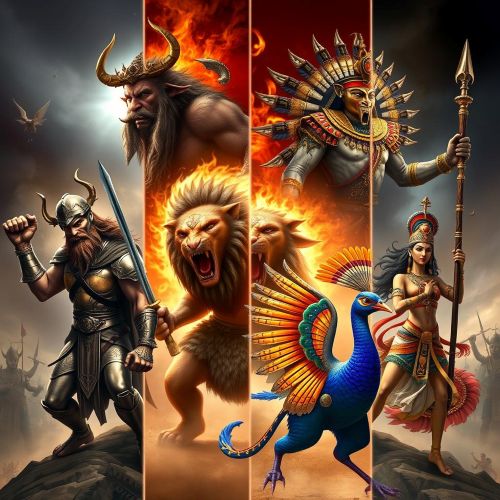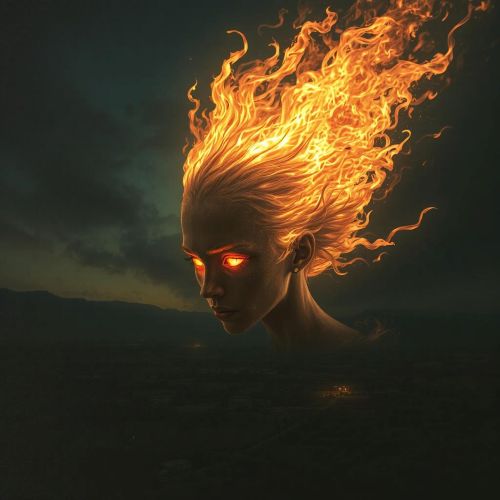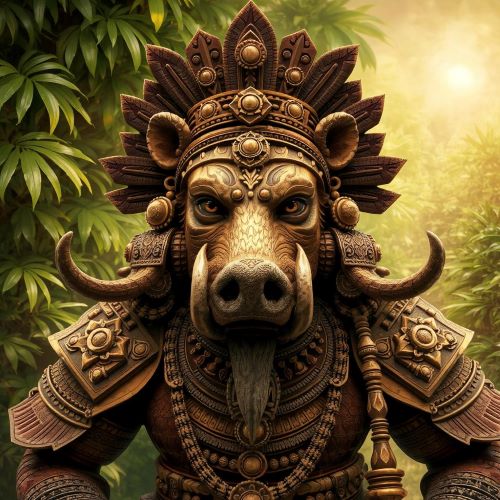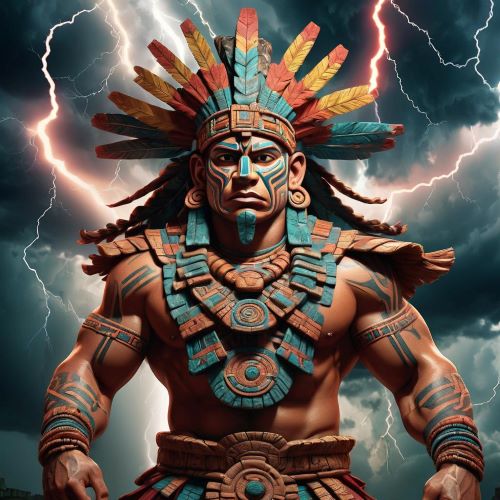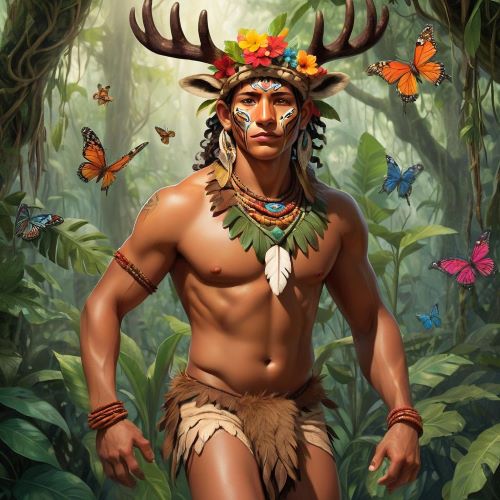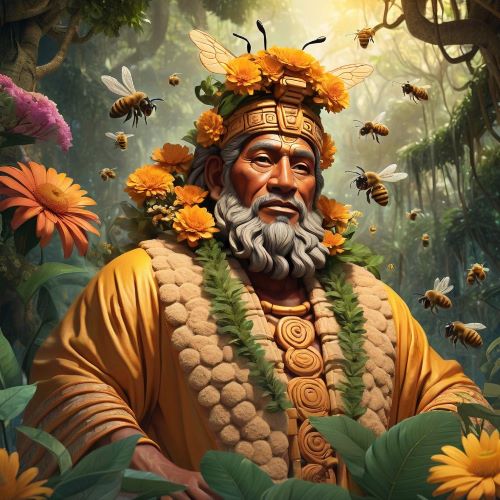Bolon Tzacab : The One Legged God
Listen
At a glance
| Description | |
|---|---|
| Origin | Mayan Mythology |
| Classification | Gods |
| Family Members | N/A |
| Region | Guatemala, Honduras, Belize, El Salvador and Nicaragua. |
| Associated With | Storms, Wind, Fire |
Bolon Tzacab
Introduction
Bolon Tzacab, a deity of the ancient Maya pantheon, was revered for his multifaceted role in their cosmology. Associated with agriculture, storms, fire, and rulership, he intrigued scholars with his unique leafy appendage and enduring legacy. Known also as Huracan, his name, translating to “one leg,” underscores his distinctive attributes. As the god of storms, wind, and fire, Bolon Tzacab held a pivotal position in shaping Maya beliefs. His prominence in their mythology reflects his profound influence over both earthly and celestial realms, making him a central figure in Maya religious practices and cosmological beliefs.
Physical Traits
Depictions of Bolon Tzacab highlight his divine stature through characteristic symbols and attire that emphasize his role in Maya cosmology. Often portrayed in regal headdresses and ceremonial garb, he signifies rulership and cosmic order within Maya beliefs. His physical representation includes symbols of fertility and abundance, crucial for sustaining Maya life and prosperity. Notably, Bolon Tzacab’s name, translating to “One-Leg” in Yucatec Maya, refers to his distinctive feature of one human leg paired with a serpent or reptilian leg, symbolizing the dual forces of agricultural sustenance and stormy destruction. In Maya iconography, he embodies lightning powers, reflecting both earthly and celestial energies. Another intriguing feature is a leafy appendage from his nose, interpreted by scholars as either a maize sprout symbolizing agriculture or a smoking object representing his association with fire and ritual offerings.
Family
In the intricate web of Mayan mythology, Bolon Tzacab is intricately connected to other deities who collectively govern various cosmic realms. Often regarded as a sibling or consort of Ixchel, the esteemed goddess of fertility and medicine, Bolon Tzacab symbolizes the essential balance of masculine and feminine energies crucial for creation and renewal. While specifics about Bolon Tzacab’s familial lineage remain elusive, Maya beliefs depict a complex pantheon where some gods embody multiple aspects or roles.
Scholars speculate that Bolon Tzacab might be an aspect of larger deities like Hunab Ku, the sky god, or Huracan, the storm god known as the “One-Legged God.” Both share similarities with Bolon Tzacab, such as the single leg and associations with storms, though Huracan is often depicted with a more fearsome and destructive persona. Bolon Tzacab, possibly representing a benevolent aspect of the storm deity, brings life-sustaining rains alongside potential for natural upheaval. His portrayal as a scepter wielded by Maya rulers suggests a royal lineage, highlighting his significance within Maya society and his role in fostering agricultural abundance to sustain life on Earth.
Other names
Bolon Tzacab, known by various names across different regions and contexts within Mayan mythology, reflects his diverse roles and attributes. “Huracan,” a name resonating with our modern term for hurricanes, highlights his association with powerful natural forces. In the Yucatec region, he was revered as Ah Bolon-Tzacab or Ah Bolon-Dz’acab, with “Ah” denoting “lord” or “god,” showcasing his status. Early archaeologists referred to him as “God K,” owing to the presence of the letter “K” near his depictions in codices.
In K’iche’ Maya areas, he may have been linked to the deity K’awiil or Kauil, further illustrating his multifaceted nature and regional variations in worship. Bolon Tzacab also carries epithets like “Nine Support,” symbolizing his foundational role in the cosmos, and “Lord of the Sky,” emphasizing his authority over celestial realms. These names not only highlight his divine attributes but also underscore his pivotal role in upholding cosmic order and regulating the cycles of time within Maya cosmology.
Powers and Abilities
Bolon Tzacab’s influence spans both agricultural fertility and the forces of nature among the Maya. Revered as a protector of farmers and a catalyst for bountiful maize harvests, he ensured the prosperity of the civilization through his agricultural domain. However, Bolon Tzacab’s role was not limited to benevolence; he also wielded power over storms, particularly hurricanes capable of devastating crops and endangering lives. The Maya believed his anger could unleash destructive rains and winds, illustrating his dual nature as both nurturer and potentially fearsome deity.
Some scholars suggest Bolon Tzacab had connections to fire, essential for agricultural land clearing and ritual offerings. The leafy appendage on his nose may symbolize a smoking object, representing this aspect of his influence. Moreover, Bolon Tzacab was associated with rulership, often depicted on royal regalia such as scepters. This representation underscored his role in legitimizing the divine authority of Maya kings, who acted as intermediaries between the gods and the people, responsible for ensuring prosperity and order.
As a deity bridging the terrestrial and celestial realms, Bolon Tzacab possessed diverse powers, including control over rain and thunder critical for agricultural cycles and sustaining life. He was also invoked for protection against natural calamities and malevolent forces, embodying the dual role of guardian and provider within Maya spiritual beliefs. Legends attribute to him the discovery of essential crops like maize and cacao through his mythical actions, highlighting his profound impact on Maya culture and sustenance.
Modern Day Influence
Bolon Tzacab’s legacy persists in contemporary Mayan culture despite the ancient civilization’s decline. Today, he remains a focal point in rituals aimed at securing prosperity and abundance, particularly during agricultural ceremonies and rites of passage. His imagery and symbolism continue to adorn indigenous art and craftsmanship, underscoring his enduring role as a cultural icon and spiritual guide.
In regions steeped in Mayan heritage, traditional agricultural practices still incorporate prayers and offerings to Bolon Tzacab, seeking his blessings for fruitful harvests. His presence in Mayan art and textiles serves as a poignant reminder of his lasting significance. Although the grandeur of Mayan civilization has waned, Bolon Tzacab’s influence endures, especially in areas where natural forces like storms remain potent.
Beyond his cultural prominence, Bolon Tzacab’s dual nature as a deity of creation and destruction offers valuable insights for today’s challenges. In an era grappling with issues such as climate change and environmental sustainability, understanding the balance between human activity and natural forces—reflected in Bolon Tzacab’s mythology—can inspire us to seek harmonious solutions for a sustainable future.
Related Images
Frequently Asked Questions
What is lorem Ipsum?
I am text block. Click edit button to change this text. Lorem ipsum dolor sit amet, consectetur adipiscing elit. Ut elit tellus, luctus nec ullamcorper mattis, pulvinar dapibus leo.
What is lorem Ipsum?
I am text block. Click edit button to change this text. Lorem ipsum dolor sit amet, consectetur adipiscing elit. Ut elit tellus, luctus nec ullamcorper mattis, pulvinar dapibus leo.
What is lorem Ipsum?
I am text block. Click edit button to change this text. Lorem ipsum dolor sit amet, consectetur adipiscing elit. Ut elit tellus, luctus nec ullamcorper mattis, pulvinar dapibus leo.
What is lorem Ipsum?
I am text block. Click edit button to change this text. Lorem ipsum dolor sit amet, consectetur adipiscing elit. Ut elit tellus, luctus nec ullamcorper mattis, pulvinar dapibus leo.
What is lorem Ipsum?
I am text block. Click edit button to change this text. Lorem ipsum dolor sit amet, consectetur adipiscing elit. Ut elit tellus, luctus nec ullamcorper mattis, pulvinar dapibus leo.

